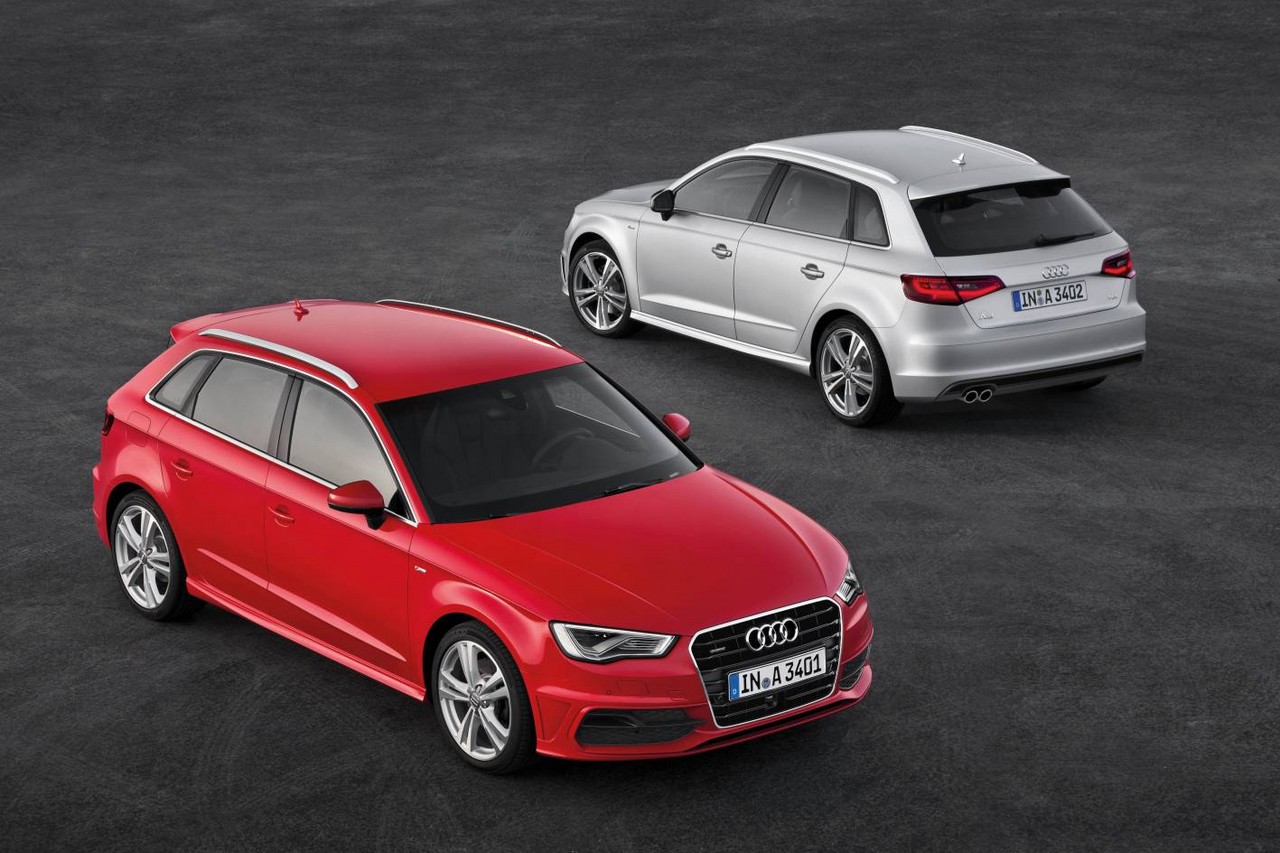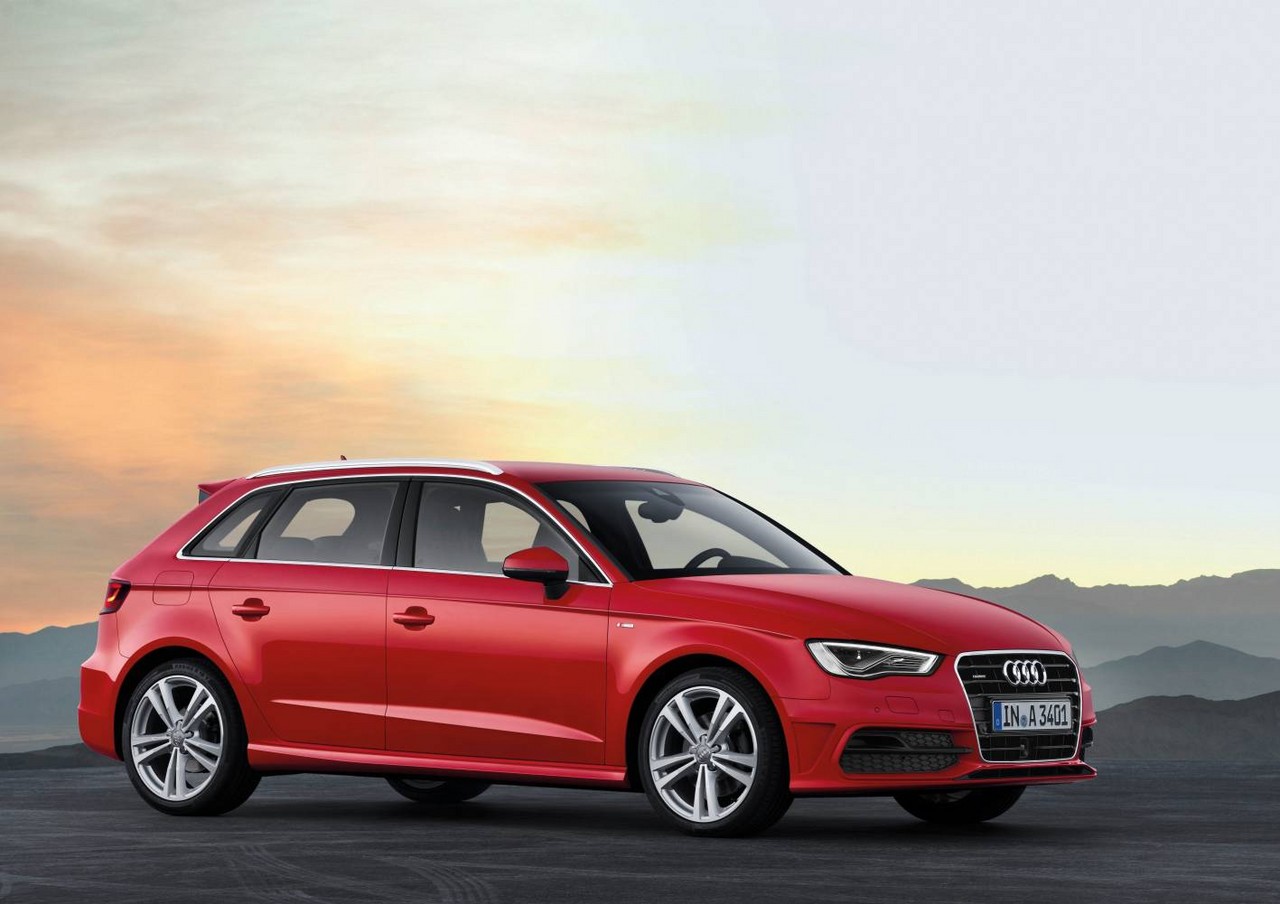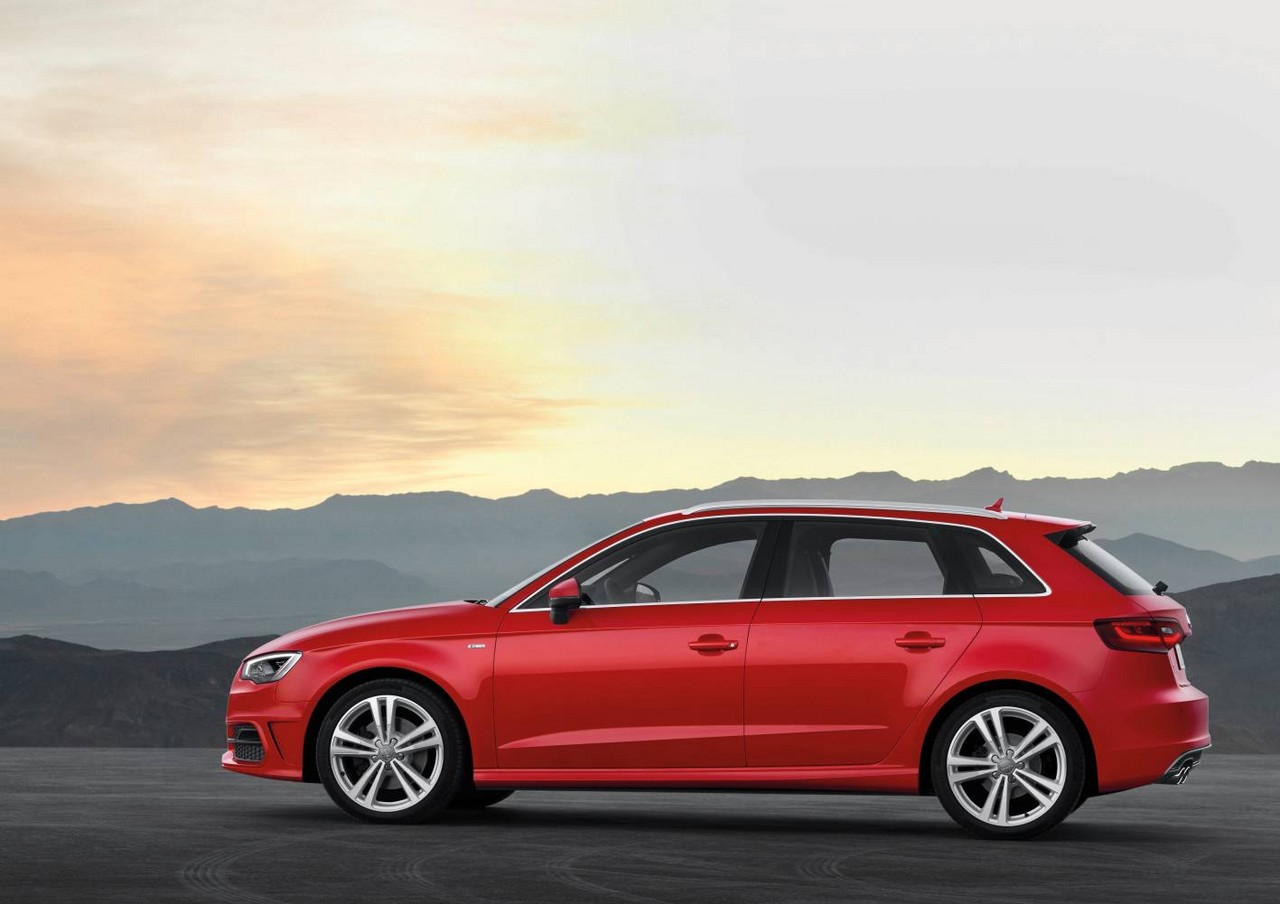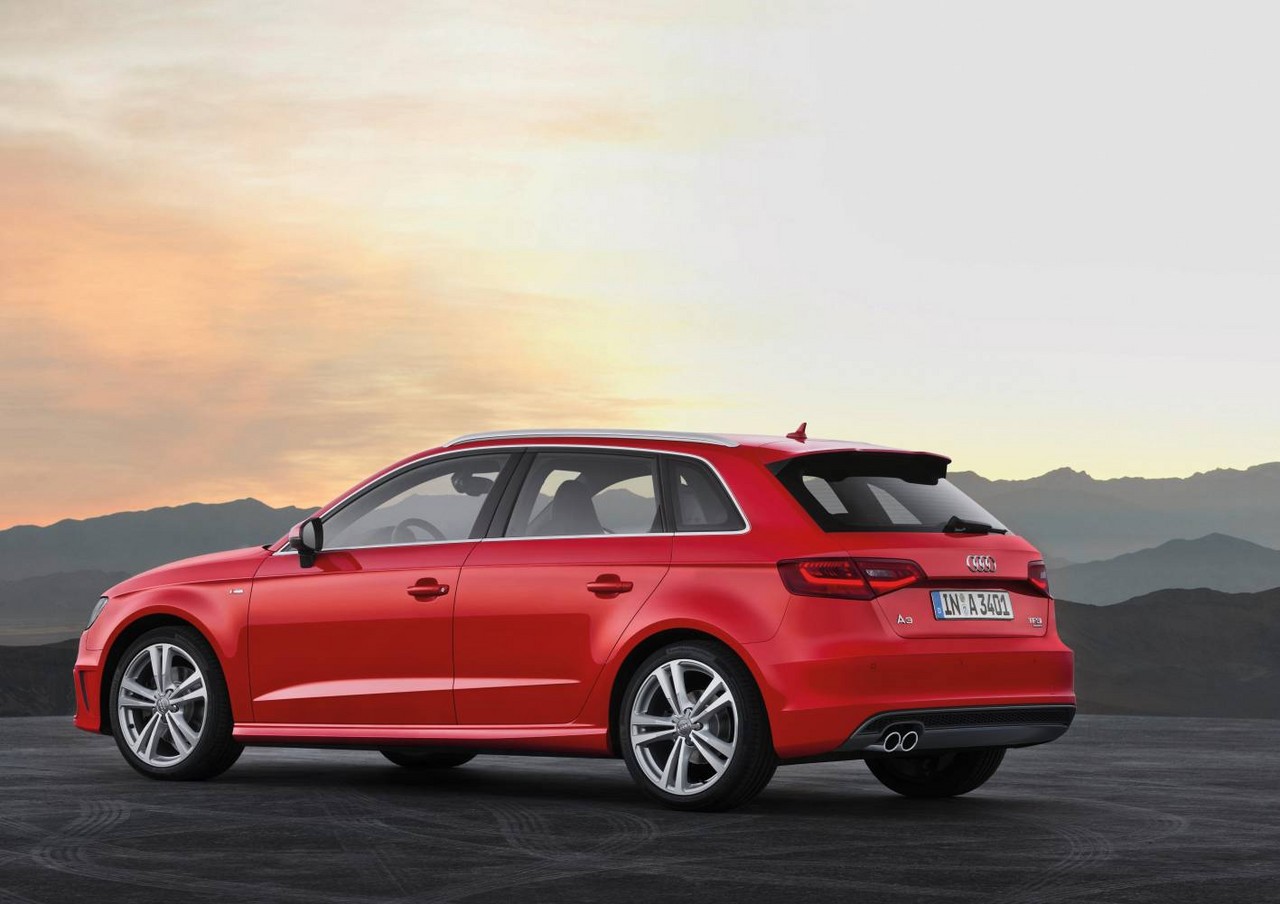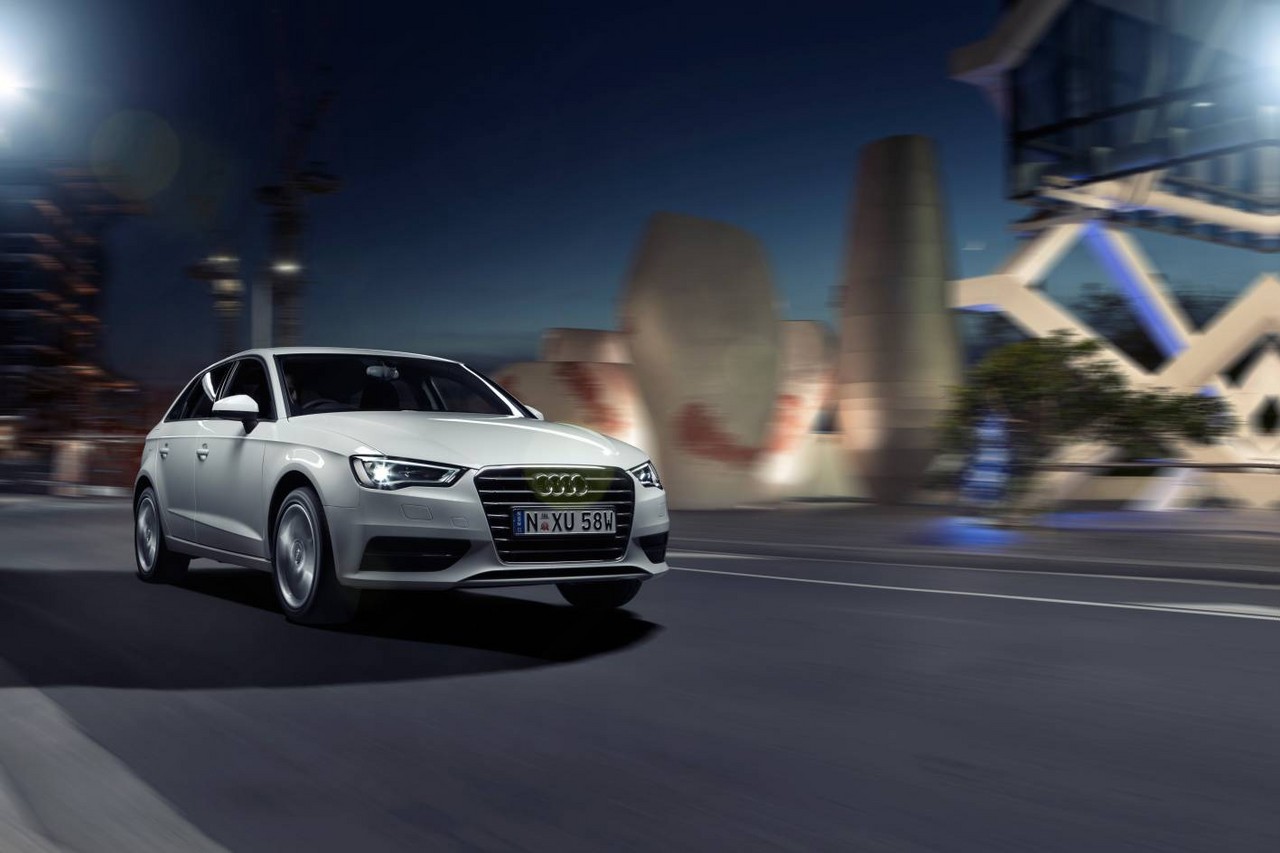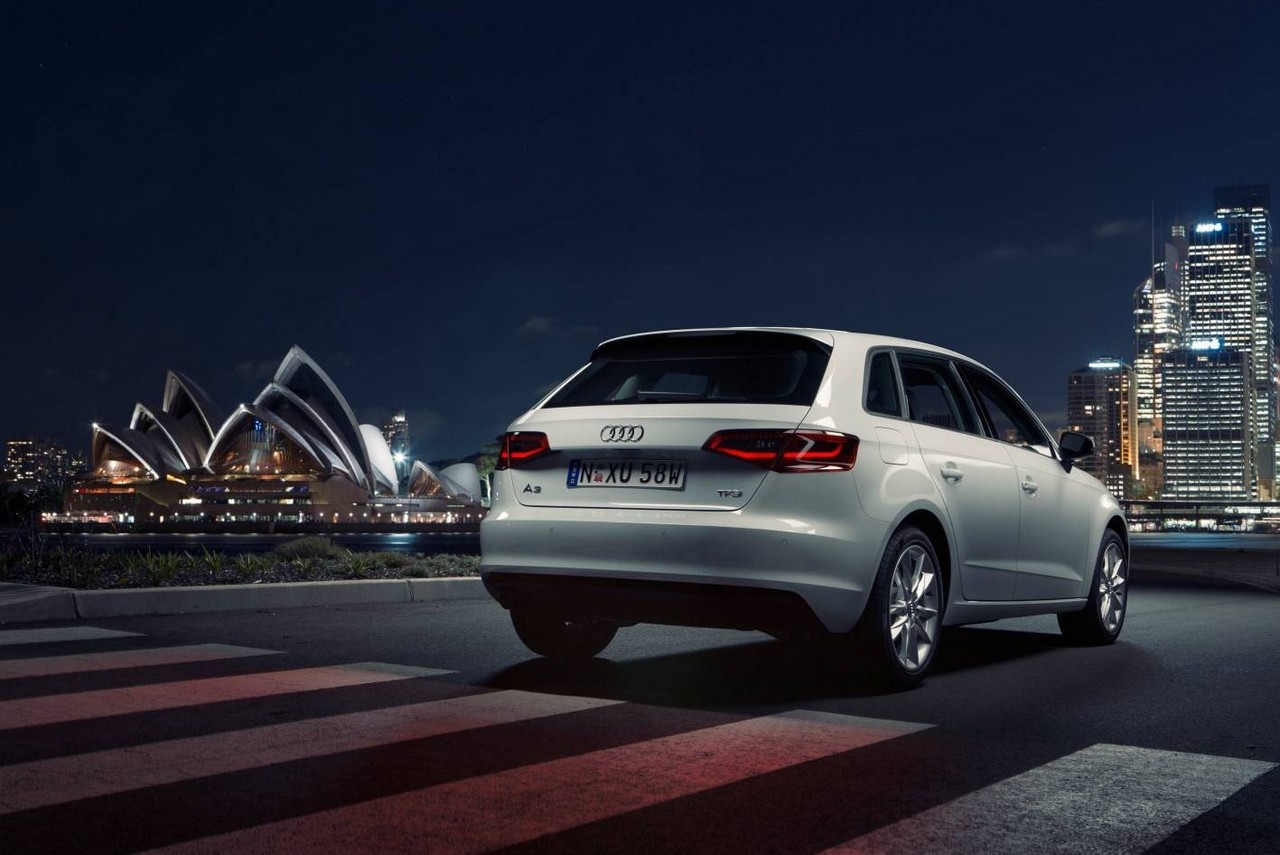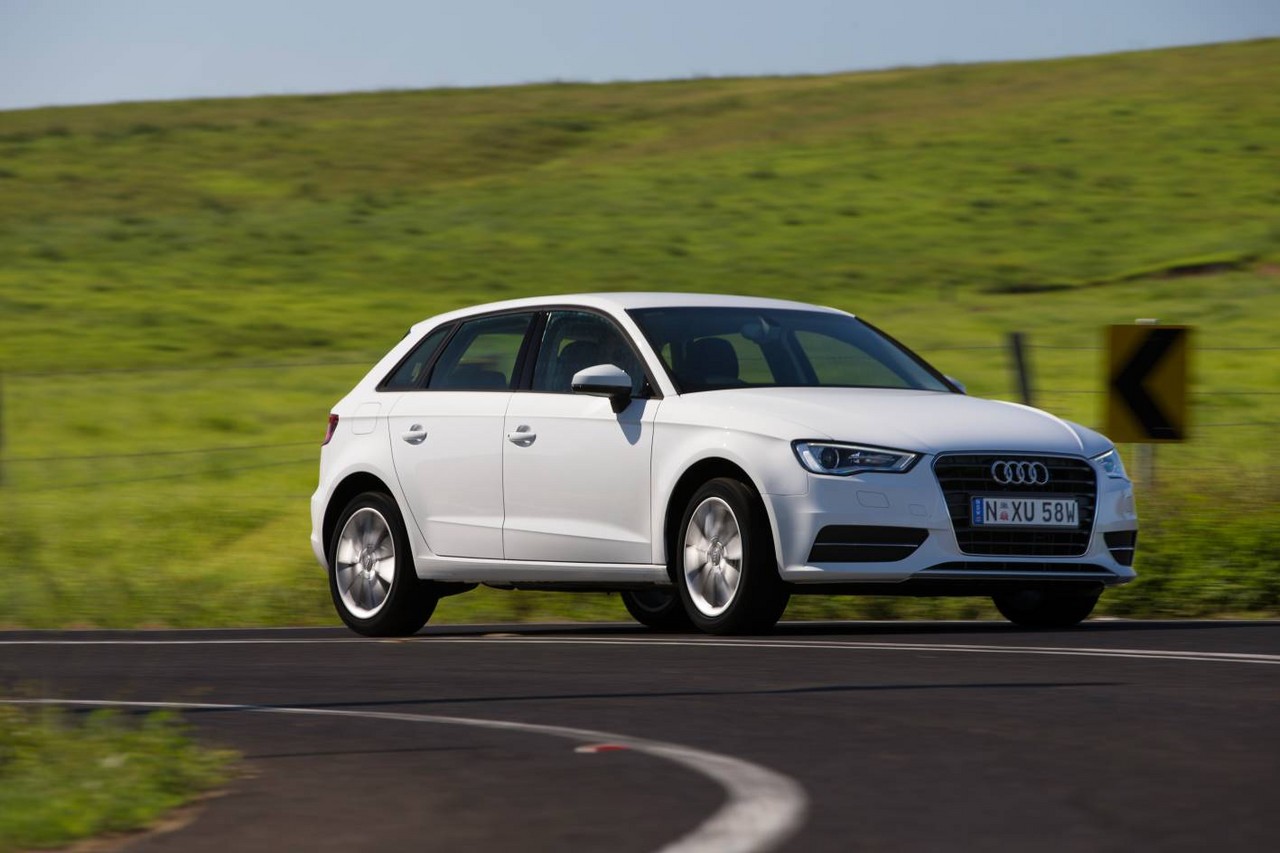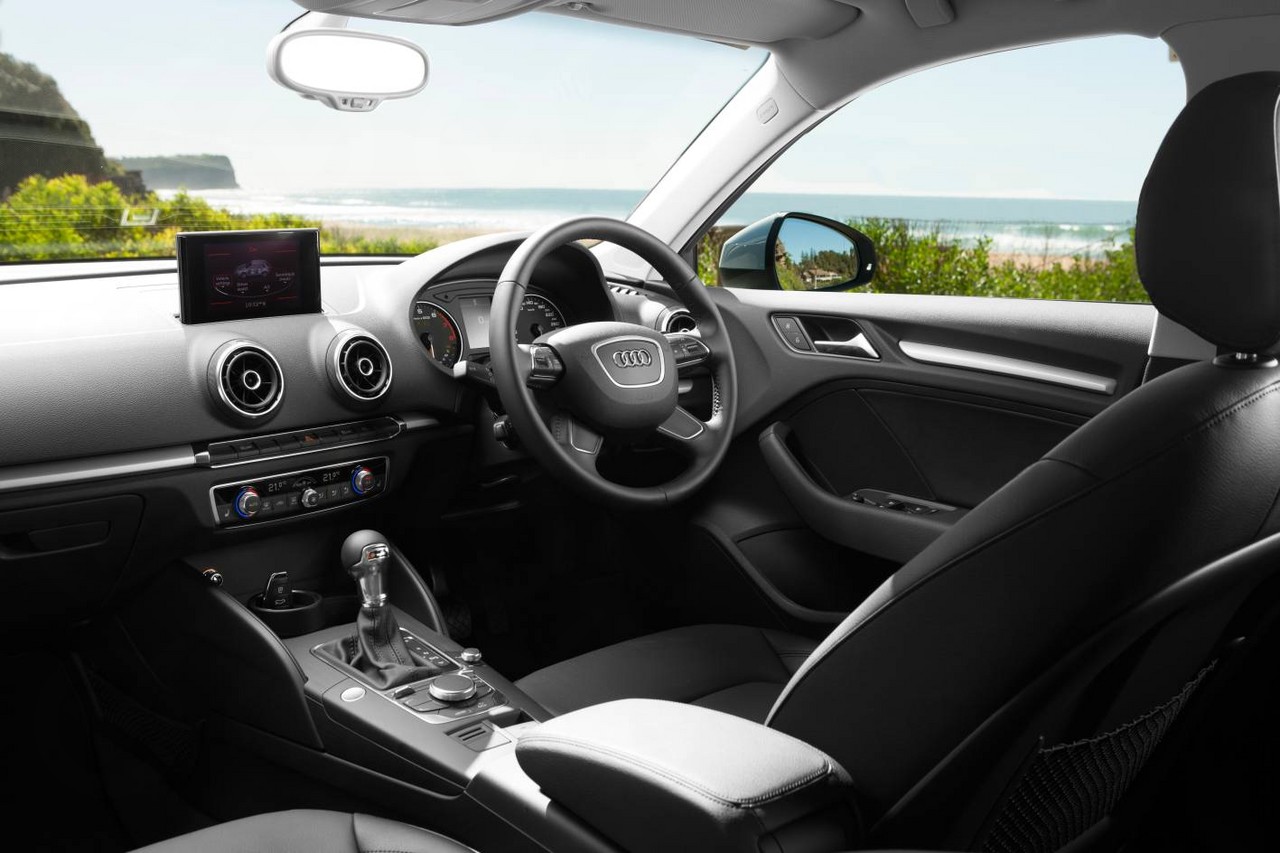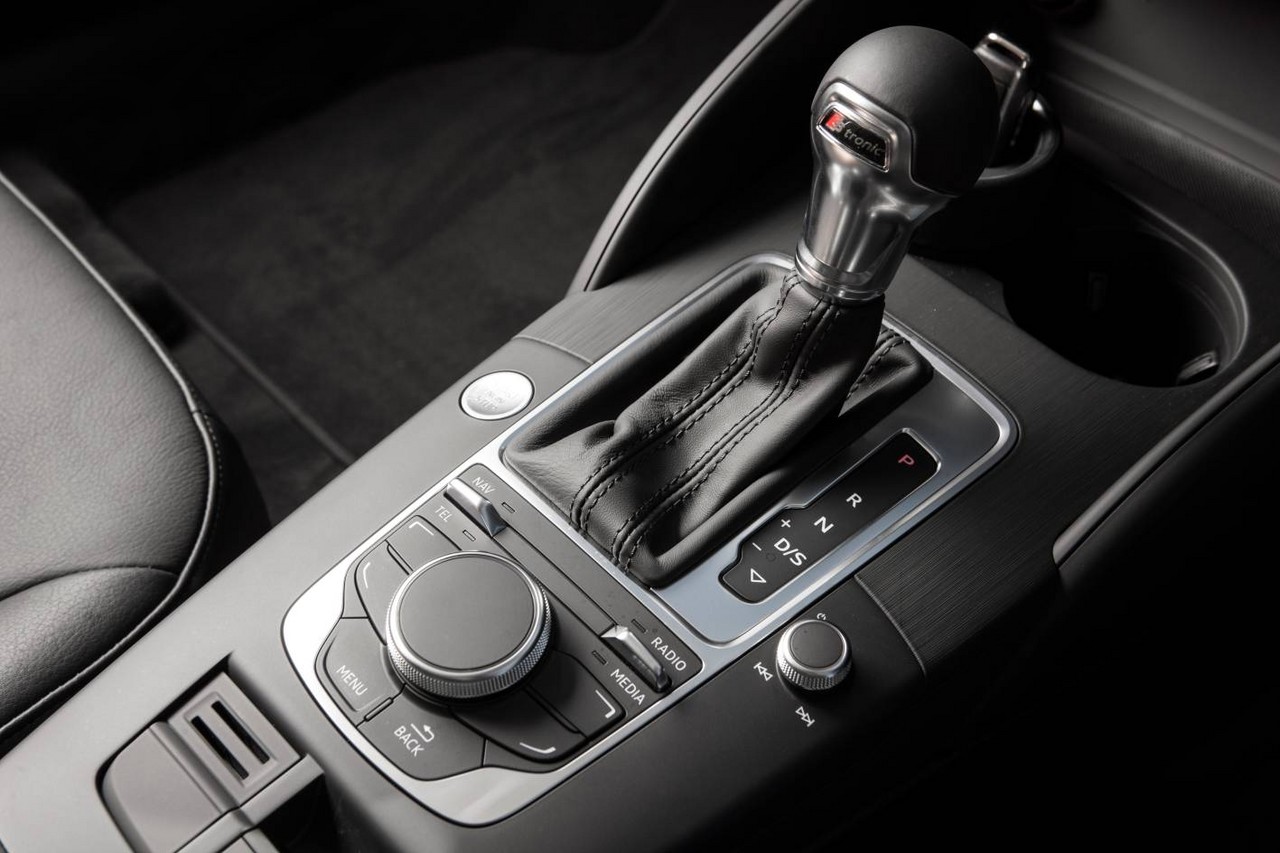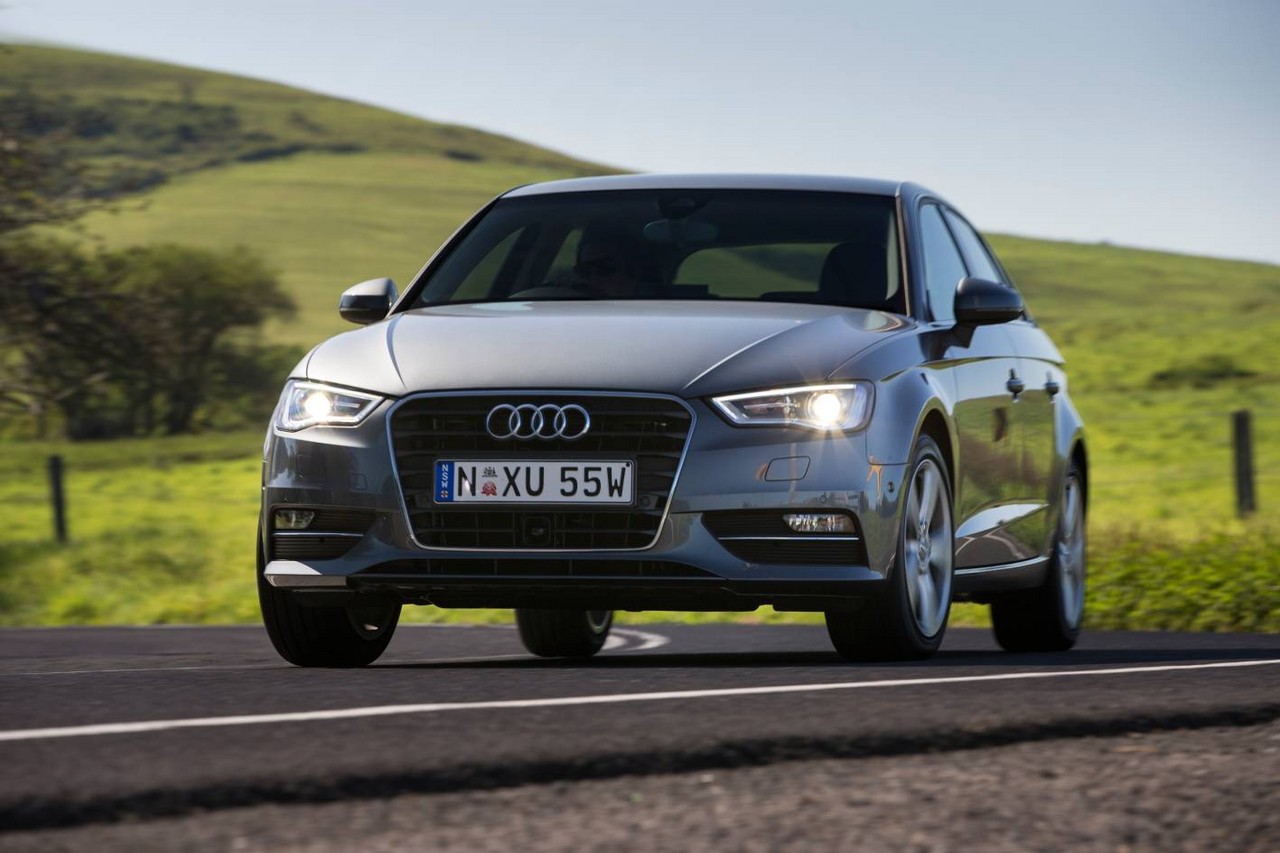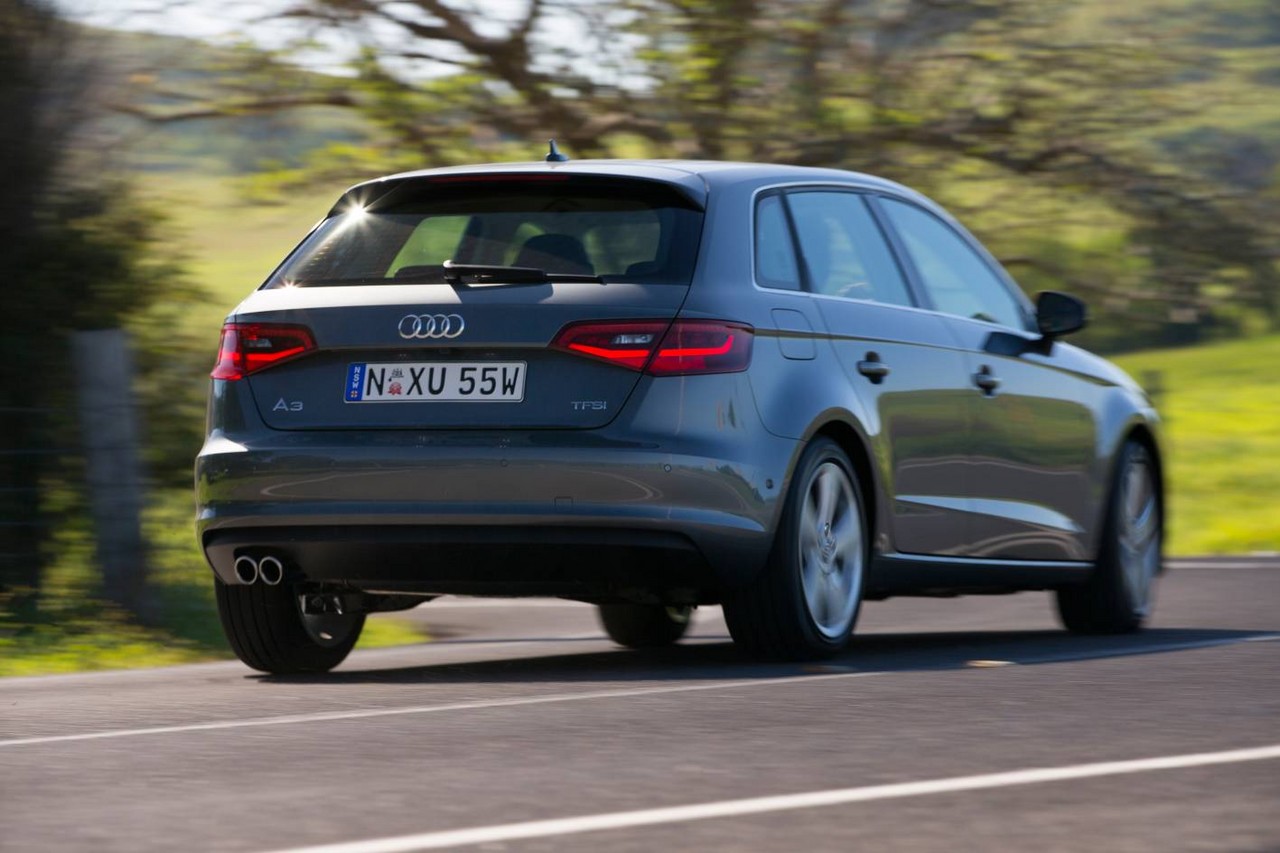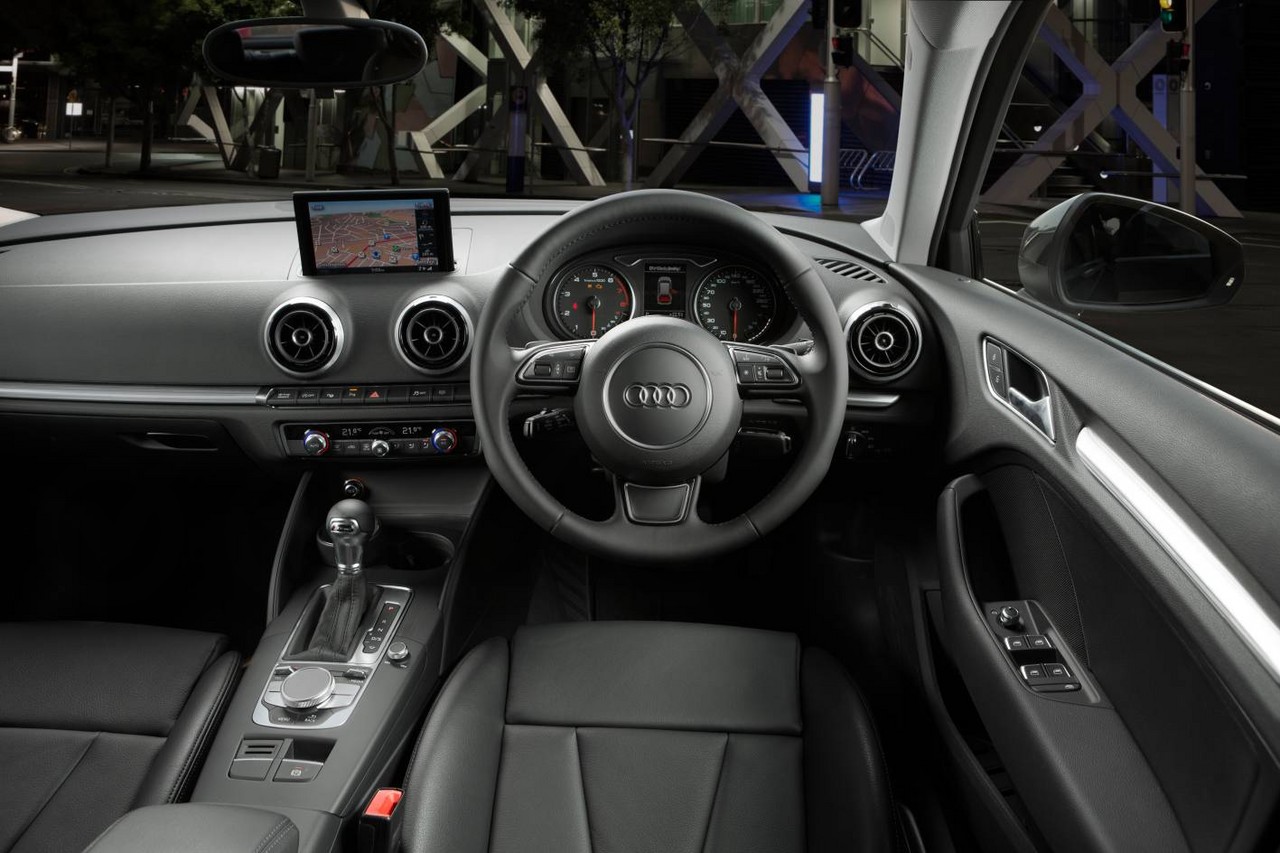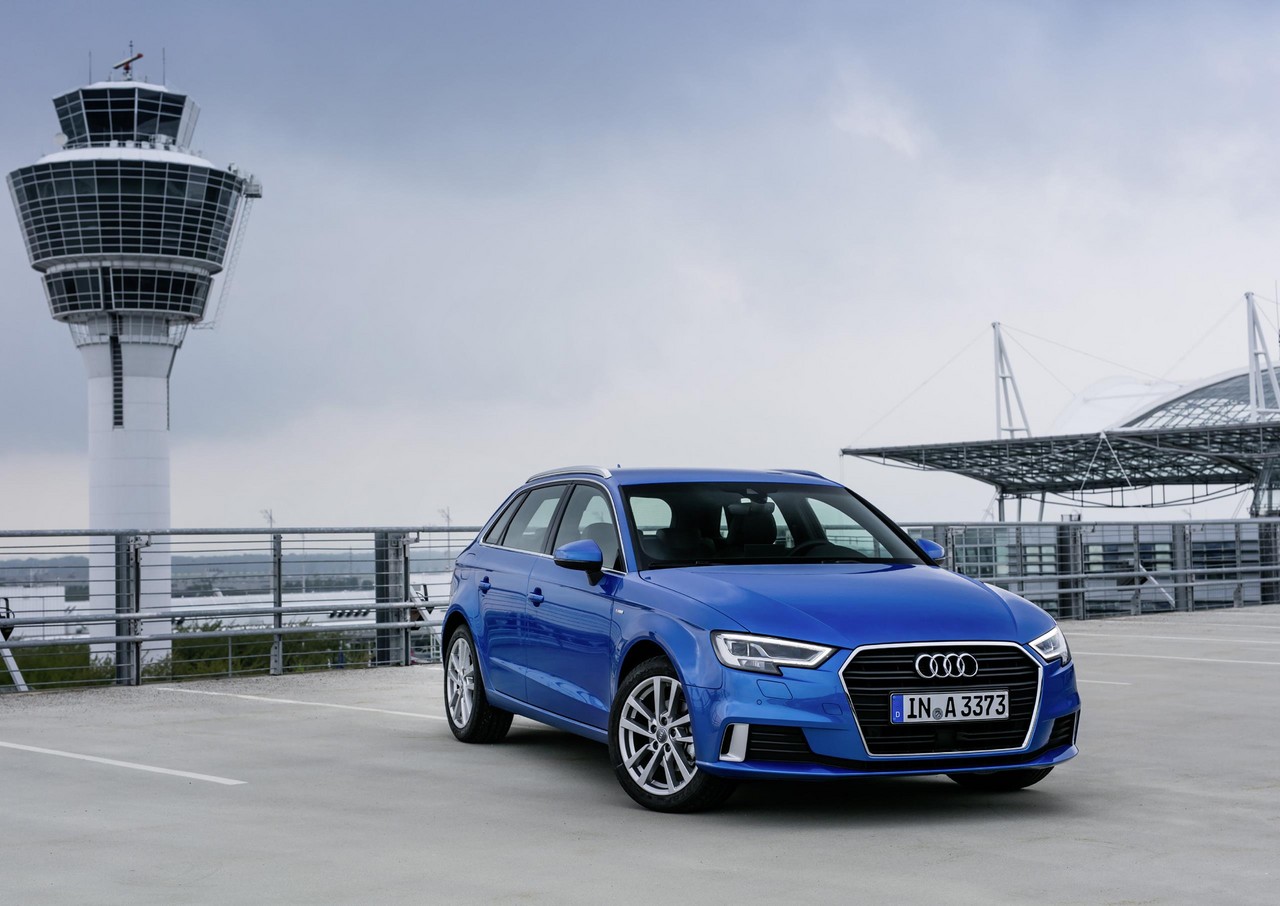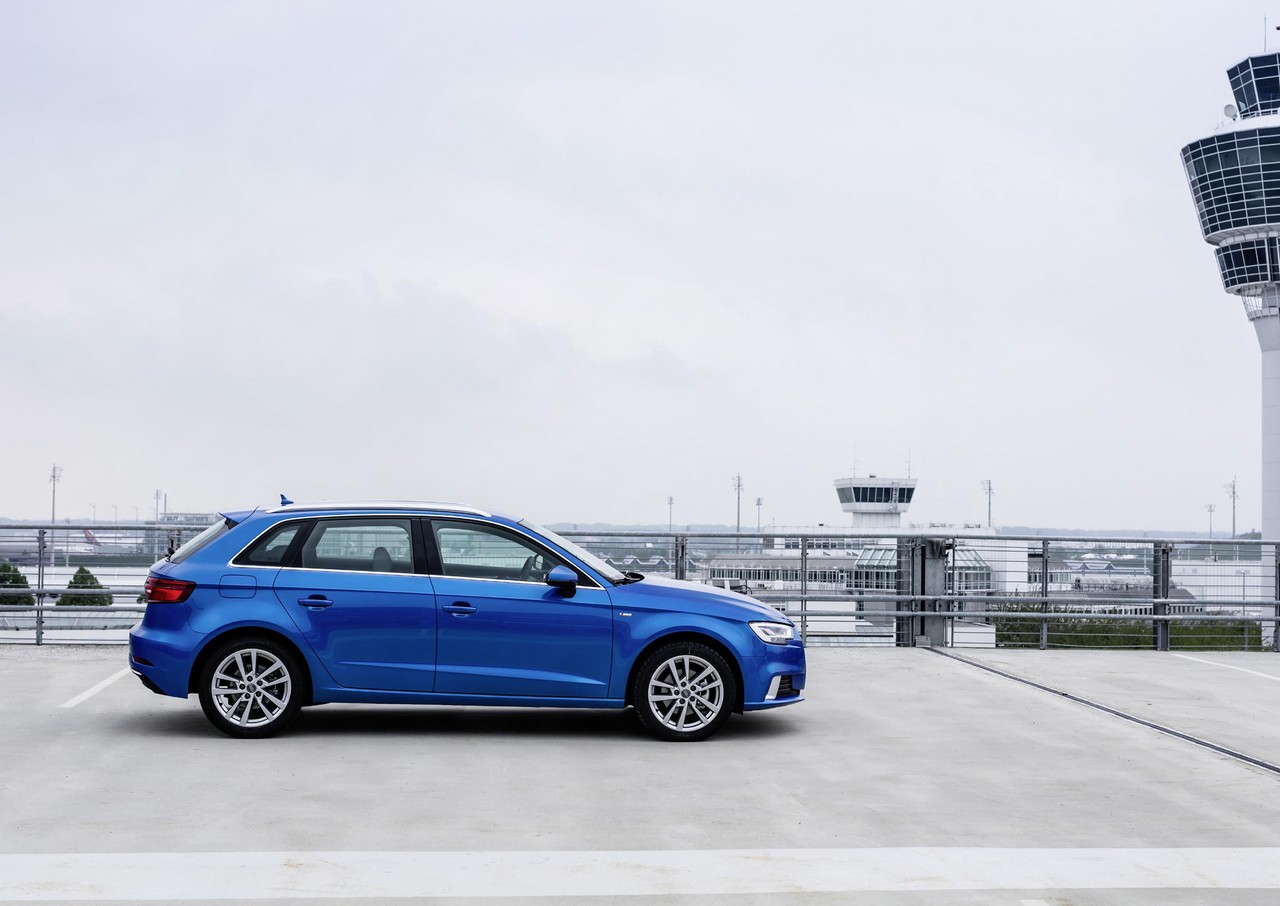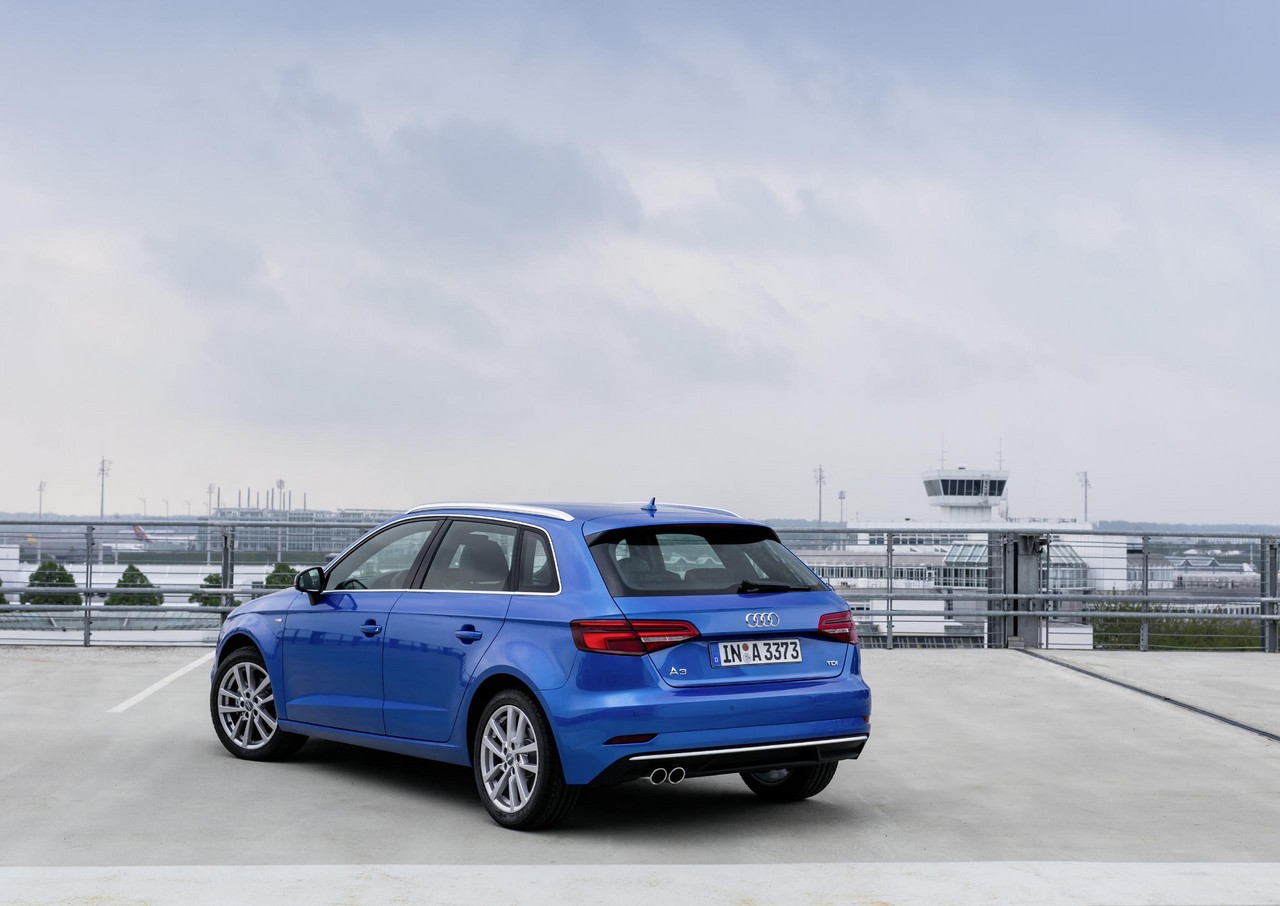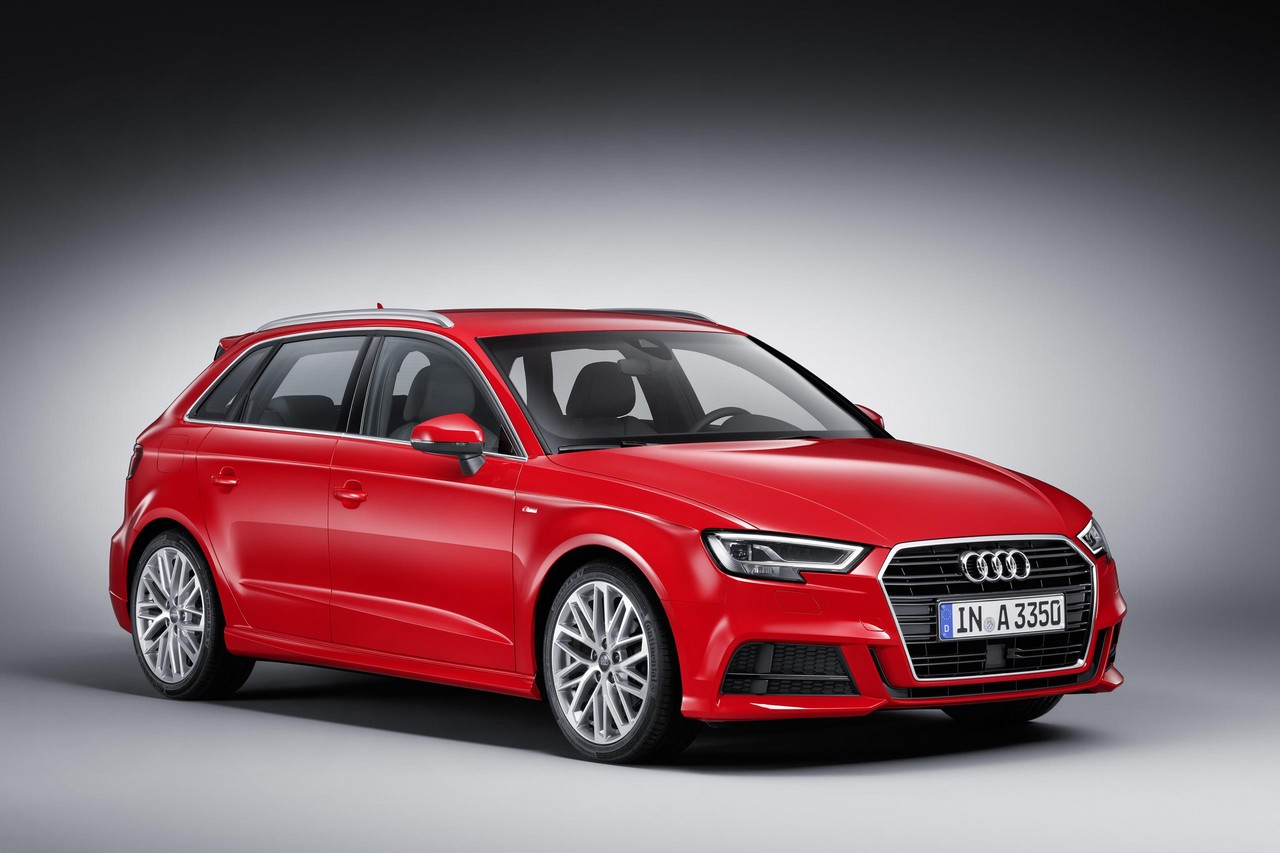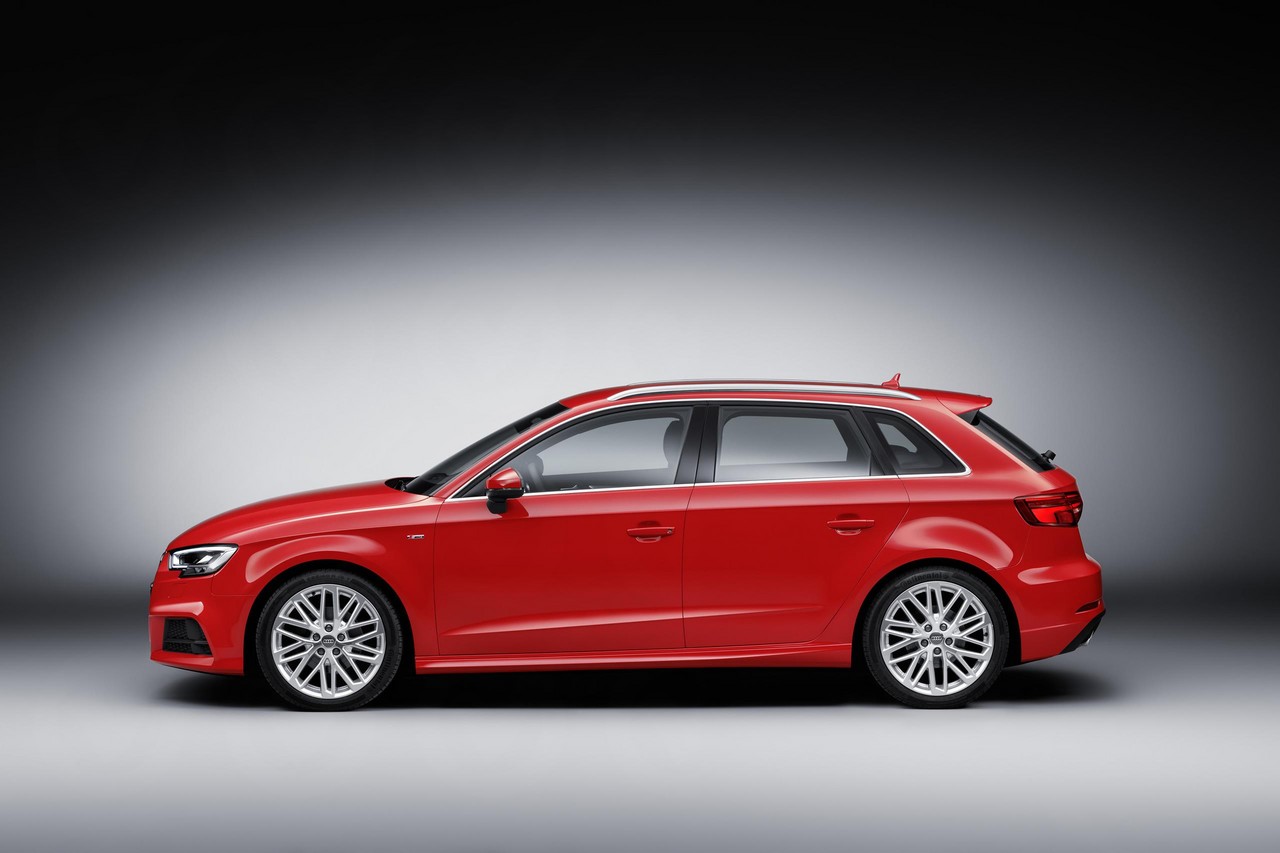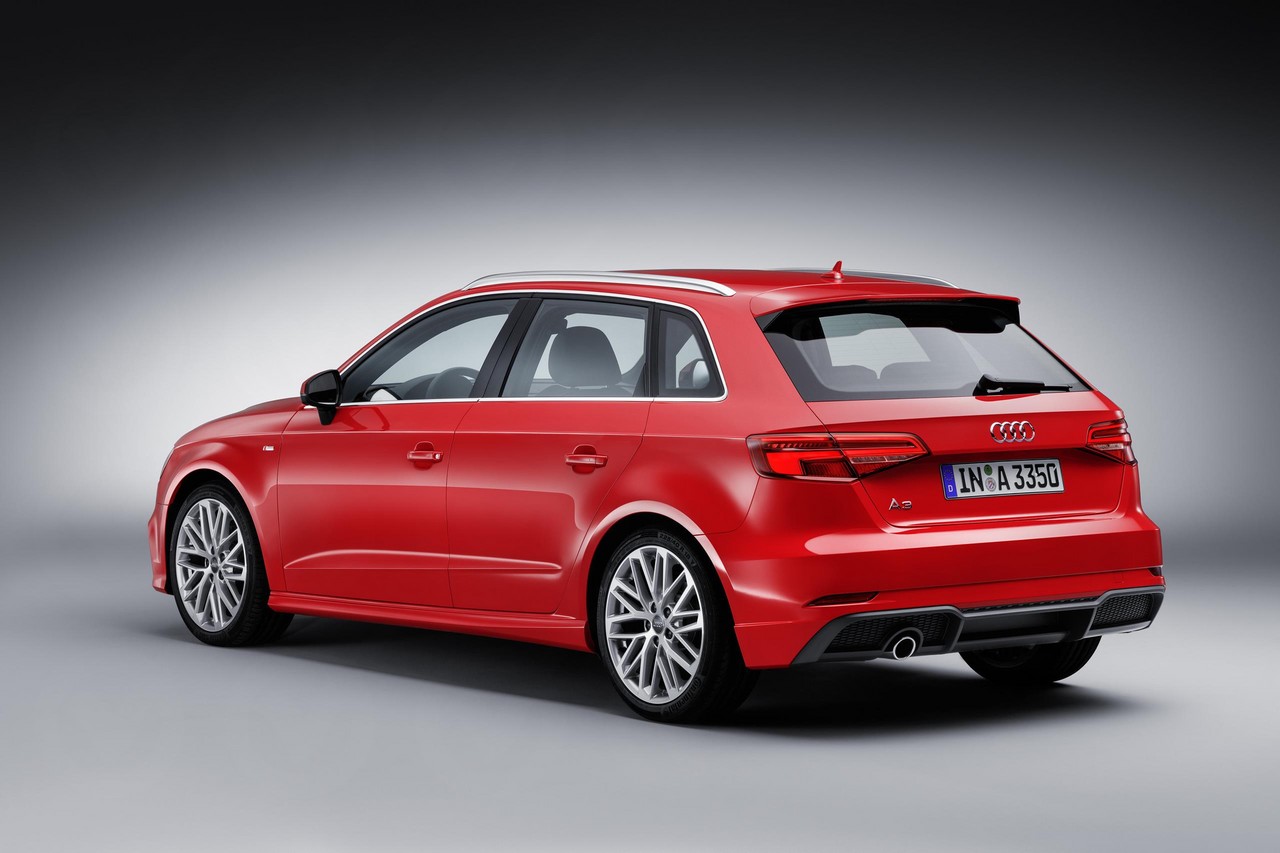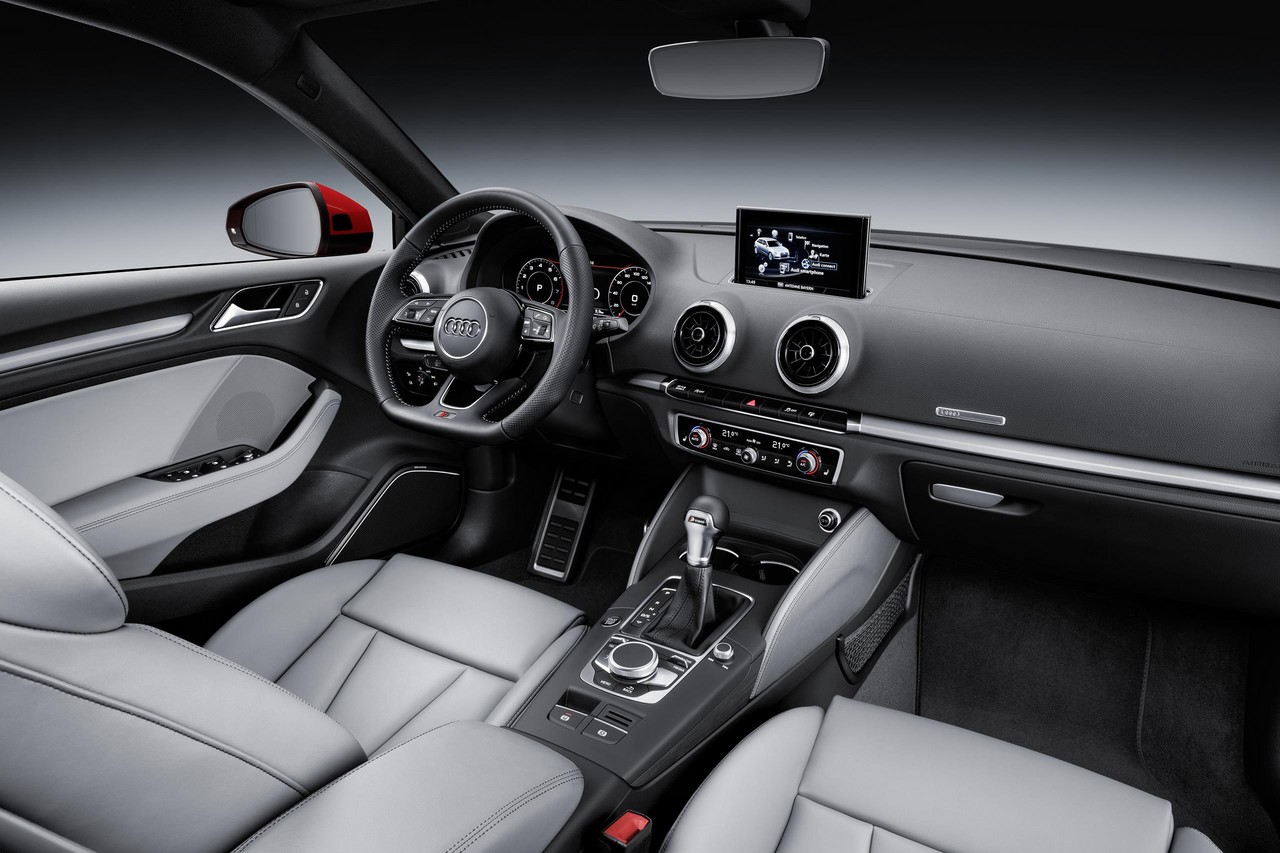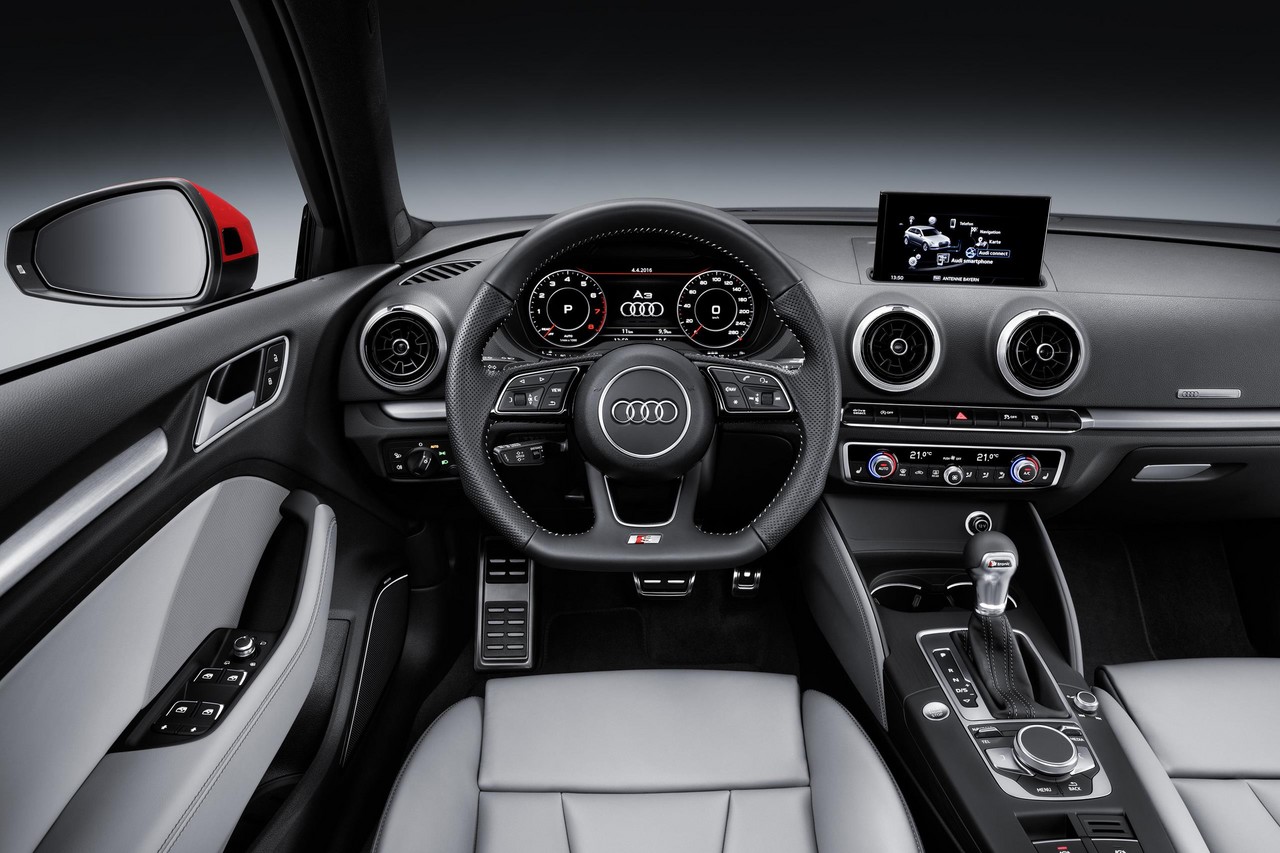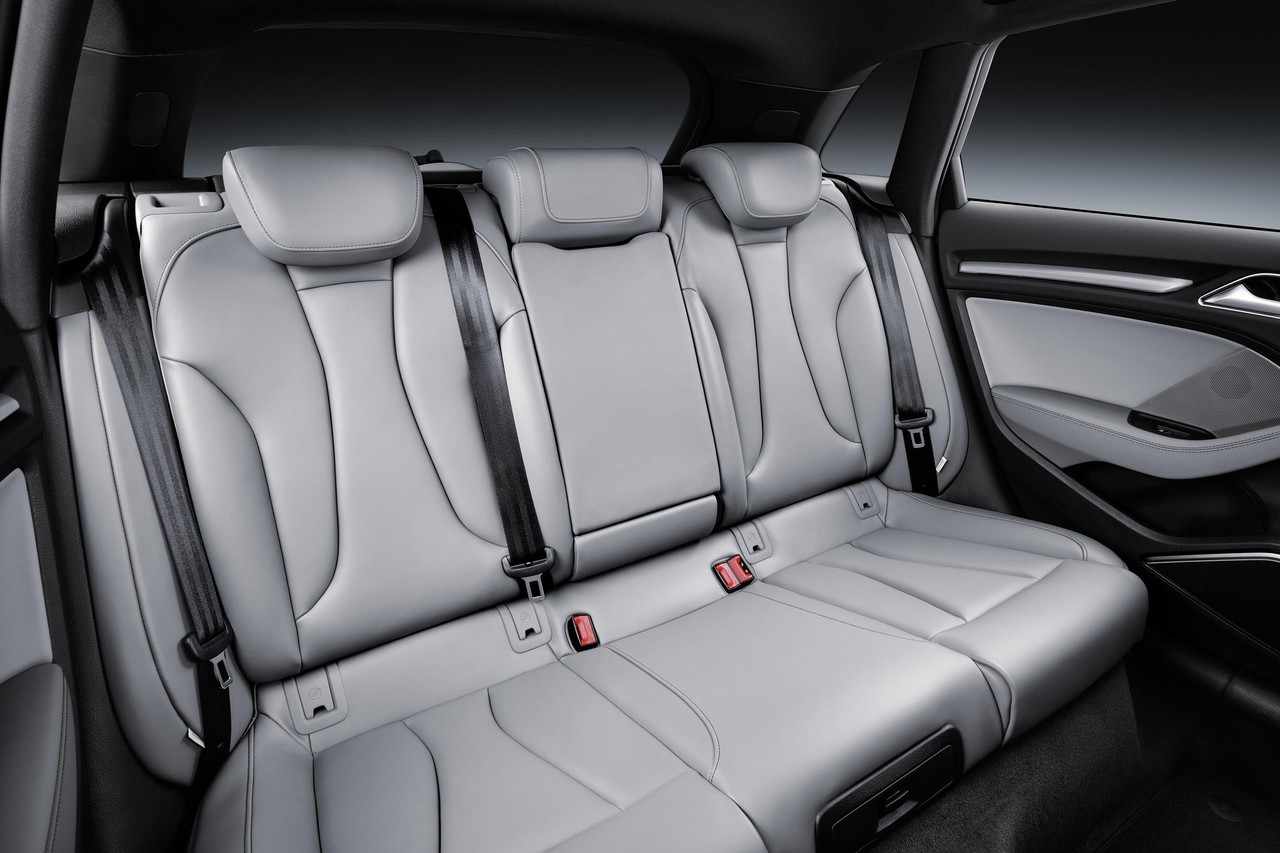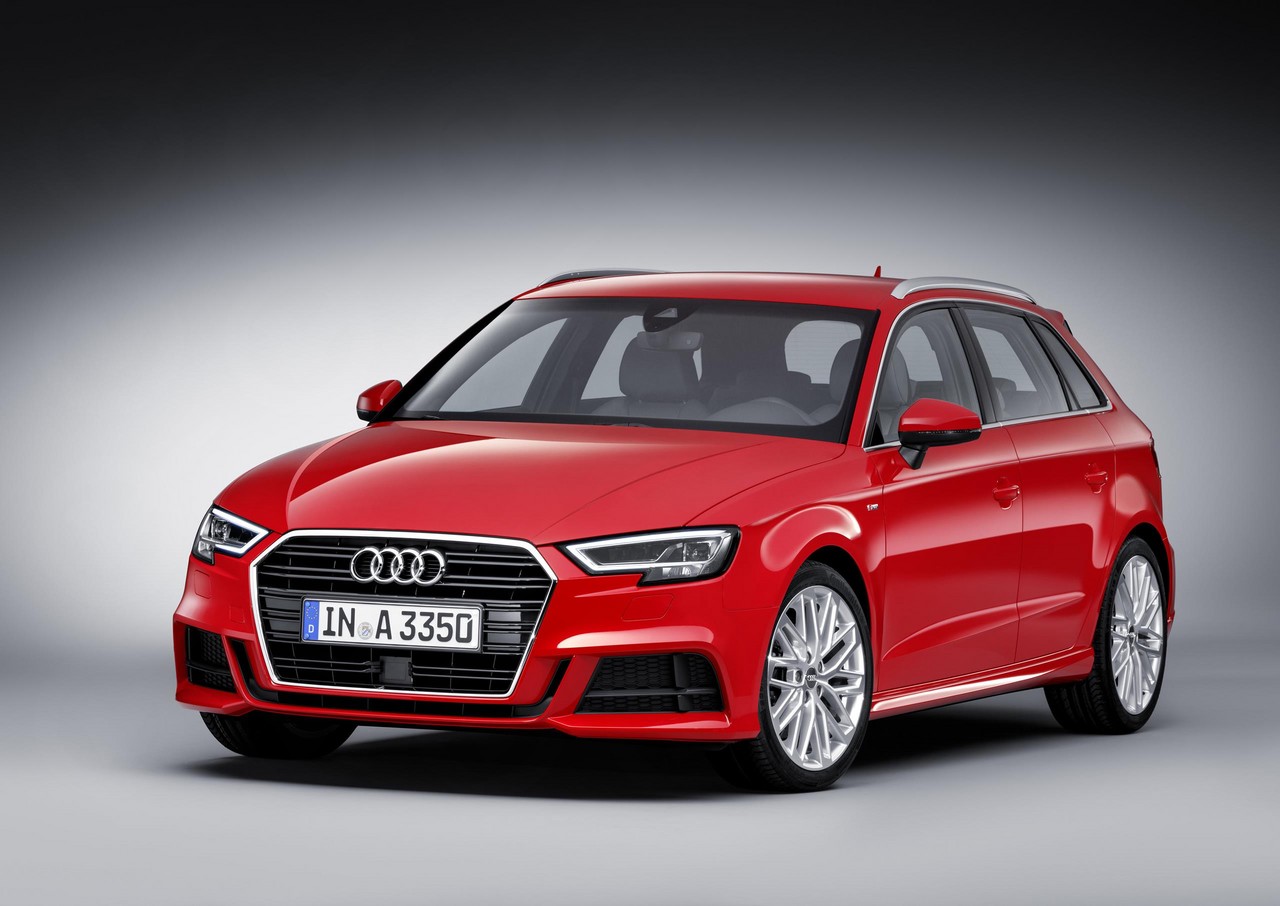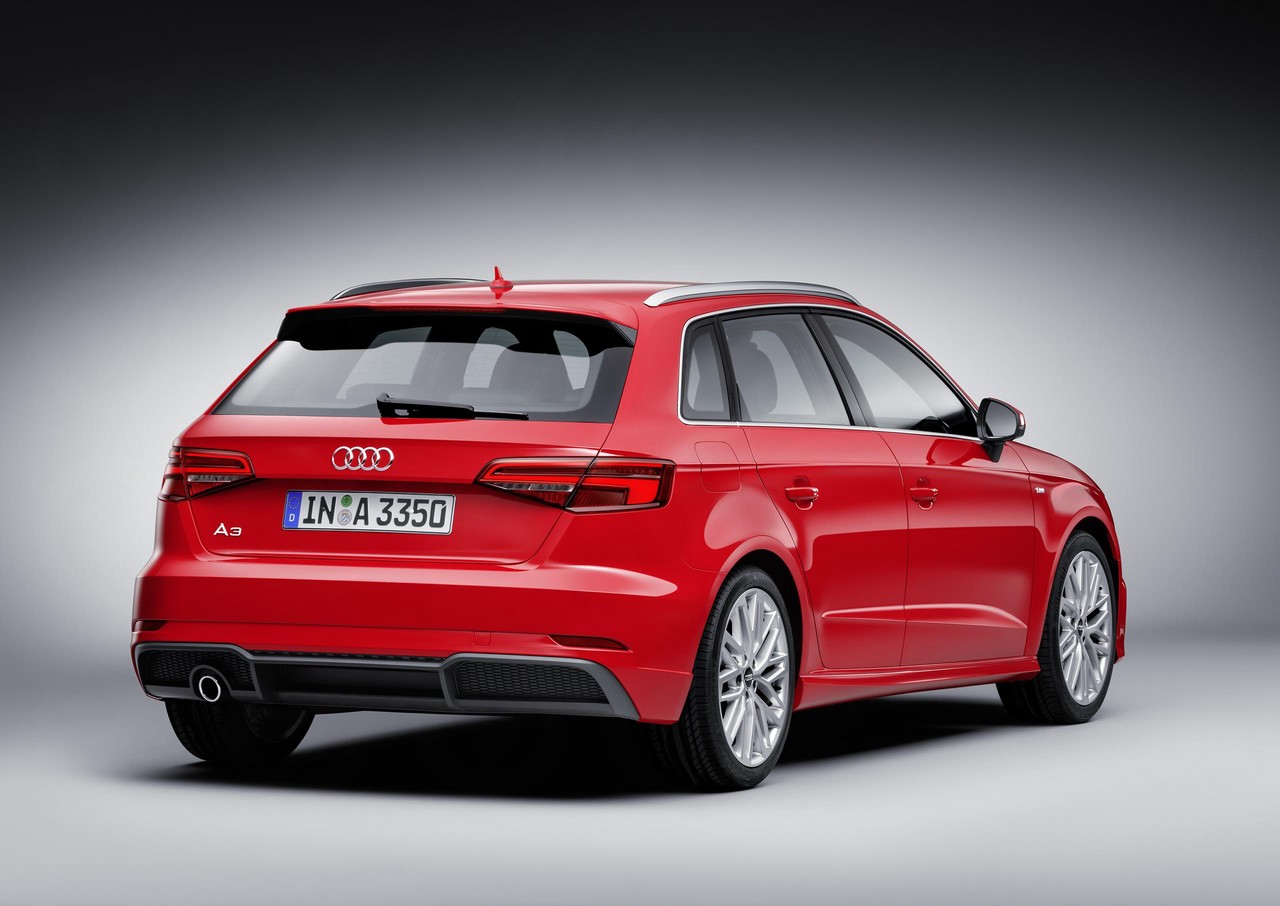
- Fuel-efficient powertrains
- High standard of interior fit and finish
- Light yet rigid chassis
- Accurate steering
- Premium pricing makes related Volkswagen Mk.7 Golf better value
- Six-speed double clutch transmission can hesitate when shifting
Review: Audi 8VA.I A3 Sportback (2013-16)
Overview
Released in May 2013, the Audi 8VA A3 Sportback was a small, five-door hatchback. Manufactured in Ingolstadt, Germany, the 8VA A3 Sportback range initially consisted of 1.4 TFSI, 1.8 TFSI, 1.6 TDI and 2.0 TDI variants. In September 2013, the range was expanded with the introduction of 1.4 TFSI CoD (Cylinder on Demand) variants and all-wheel drive 1.8 TFSI variants.
All of these variants were fitted with double clutch transmissions (Audi’s ‘S-Tronic’), though manual transmissions were available by special order. Of the engines, all featured direct fuel injection and Audi’s start-stop system which would shut down the engine when the vehicle was stationary. The 1.4 TFSI CoD, however, could also shut down two engine cylinders under low load and coasting conditions.
| Variant | Edition | Engine | Trans. | Peak power | Peak torque | Years |
|---|---|---|---|---|---|---|
| 1.6 TDI | Attraction | 1.6-litre CLHA turbo-diesel I4 | 6sp DCT | 77 kW at 3000-4000 rpm | 250 Nm at 1500-2750 rpm | 2013-14 |
| 81 kW at 3200-4000 rpm | 250 Nm at 1500-3000 rpm | 2014-16 | ||||
| 2.0 TDI | Ambition | 2.0-litre CRBC/CRLB turbo-diesel I4 | 6sp DCT | 110 kW at 3500 rpm | 320 Nm at 1750-3000 rpm | 2013-16 |
| 1.4 TFSI | Attraction | 1.4-litre CXSA/CZCA turbo petrol I4 | 7sp DCT | 90 kW at 5000-6000 rpm | 200 Nm at 1400-4000 rpm | 2013-14 |
| 1.4-litre turbo petrol I4 | 7sp DCT | 92 kW at 5000-6000 rpm | 200 Nm at 1400-4000 rpm | 2014-16 | ||
| 1.4 TFSI CoD | Attraction | 1.4-litre CPTA/CZEA turbo petrol I4 | 7sp DCT | 103 kW at 5000 rpm | 250 Nm at 1500-3500 rpm | 2013-14 |
| 1.4-litre turbo petrol I4 | 7sp DCT | 110 kW at 5000-6000 rpm | 250 Nm at 1500-3500 rpm | 2014-16 | ||
| 1.8 TFSI | Ambition | 1.8-litre CJSA turbo petrol I4 | 7sp DCT | 132 kW at 5100-6200 rpm | 250 Nm at 1250-5000 rpm | 2013-16 |
| 1.8 TFSI quattro | Ambition | 1.8-litre CJSA turbo petrol I4 | 6sp DCT | 132 kW at 4500-6200 rpm | 280 Nm at 1350-4500 rpm | 2013-16 |
| e-tron | N/A | 1.4-litre turbo petrol I4 | 6sp DCT | 110 kW at 5000-6000 rpm | 250 Nm at 1600-3500 rpm | 2015-16 |
| Electric motor | 75 kW | 330 Nm at 0-2200 rpm | ||||
| Combined | 150 kW | 350 Nm | ||||
Audi 8VA A3 Sportback e-tron
Released in Australia in July 2015, the Audi A3 Sportback e-tron was a plug-in hybrid. As such, the powertrain for the A3 Sportback e-tron consisted of a 75 kW electric motor and a 1.4-litre turbocharged four-cylinder petrol engine. The electric motor drew power from an 8.8 kWh battery which consisted of 96 prismatic cells (arranged into eight modules) and was positioned under the rear seats. Including electrical components, the battery system had a mass of 125 kg.
The electric motor was located between the petrol engine’s dual-mass flywheel and the separating clutch (K0). Together with the K0 separating clutch, the electric motor is integrated into a newly designed six speed e-S tronic transmissions. Like other Audi dual-clutch transmissions, it consisted of two subsidiary transmissions that are served by the two multi-plate clutches K1 and K2.
When operating solely on electric power, the A3 Sportback e-tron had an estimated range of 50 km. When the TFSI engine started, however, it was ‘tow-started’ by the electric motor via the clutch and, once the TFSI engine had reached the same speed as the electric motor, the separating clutch was opened. The A3 Sportback e-tron enabled the driver to select from three drive modes –
- EV: gave priority to electric drive (i.e. not using the petrol engine);
- S: for sporty driving, S mode would more readily activate the petrol engine for additional power; and,
- Hybrid hold: preserved the electrical energy stored in the battery for later use by limiting use of the electrical motor.
Body and dimensions
Like the Volkswagen Mk.7 Golf , the 8VA A3 Sportback was based on Volkswagen’s MQB platform. As a result, mass was reduced by as much as 90 kg relative to the Audi 8P A3 Sportback in part due to the use of high- and ultra-high strength steels. The 1.4 TFSI variant, for example, has a kerb mass of 1205 kg.
Compared to the Audi 8P A3 Sportback , the 8VA A3 Sportback was 18 mm longer (at 4310 mm), 20 mm wider (1785 mm), 2 mm taller (1425 mm) and had a 58 mm longer wheelbase (2636 mm). Furthermore, the front suspension was mounted on an aluminium subframe and utilised MacPherson struts with wishbones and lightweight aluminium pivot bearings; the independent, four-link rear suspension was mounted on a steel subframe.
quattro all-wheel drive
For the 8VA A3 Sportback 1.8 TFSI quattro, the all-wheel drive system had a newly developed multi-plate clutch which was hydraulically actuated and electronically controlled. In normal conditions, drive was directed to the front wheels, though Audi claimed that the system could transfer up to 50 per cent of the engine’s torque ‘from the front to the rear axle in just a few milliseconds’.
Safety equipment
Standard safety equipment for the Audi 8VA A3 Sportback included dual front airbags, a driver’s knee airbag, front side airbags, full-length curtain airbags, ABS, electronic brake force distribution, brake assist, electronic stability control, traction control and fronts seatbelts with pre-tensioners and load limiters.
The 8VA A3 Sportback was also available with a range of optional driver assistance systems:
- Adaptive cruise control (ACC): radar-based cruise control which maintained a preset distance from the vehicle ahead. For models with the S-Tronic transmissions (standard for Australia), ACC also included a ‘stop & go’ function for low speeds;
- Side assist: a blind spot monitoring system which monitored lane changes with a rear-facing radar;
- Active lane assist: helped drivers remain in their lane by slightly correcting the electromechanical steering if necessary;
- Park assist: used twelve ultrasonic sensors to provide a 360 degree view of the vehicle and could autonomously steer the vehicle into parallel and perpendicular parking spaces (manoeuvring multiple times if necessary);
- Pre-sense basic: if the vehicle lost traction, the front seatbelts would be tensioned and the windows – and sunroof where fitted – closed;
- Pre-sense front: in the event of a pending rear-end collision with the vehicle ahead, the driver was warned and the vehicle could autonomously activate the brakes. At speeds below 30 km/h, almost maximum braking force would be applied; and,
- Multicollision brake assist: ensured the vehicle did not continue to roll in an uncontrolled fashion after an accident.
Euro NCAP testing
In Euro NCAP testing , the three-door Audi 8V1 A3 received a five star safety rating which included a 95 per cent adult occupant protection rating and an 87 per cent child occupant protection rating. In the front offset crash test, occupant protection was generally good, though chest protection was rated as adequate for the driver. Maximum points were awarded in the side impact test though, in the more severe pole test, chest protection was rated as adequate. Under ANCAP’s methodology, this testing resulted in a five star adult occupant protection rating with a score of 36.41 out of 37.
Features: A3 Sportback Attraction and Ambition
Standard features for the Audi 8VA A3 Sportback Attraction included 16-inch alloy wheels with 205/55 R16 tyres, an eight speaker sound system with an Audi’s Multi-Media Interface (MMI), an eight-inch colour display, CD player, MP3/WMA/ACC compatibility, auxiliary inputs (3.5 mm/USB/SD card) and Bluetooth connectivity, dual-zone climate control air conditioning, leather upholstery, cruise control, automatic headlights, rain-sensing wipers, rear parking sensors, a leather-wrapped steering wheel with gearshift paddles, 40/60 split and folding rear seats, remote central locking, power windows and heated mirrors, a height and reach adjustable steering wheel, an electromechnical parking brake, tyre pressure monitoring, a 12 volt power outlet in the centre console, a trip computer and an immobiliser.
The A3 Sportback Ambition was further equipped with 17-inch alloy wheels with 225/45 R17 tyres, contoured front sports seats, front fog lights, an upgraded trip computer and aluminium interior trim and door sills. The Ambition editions were also fitted with Audi’s Drive Select system which enabled the driver to select from steering and engine response settings.
Related links
Review: Audi 8VA.II A3 Sportback (2016-20)
Overview
Commencing production in May 2016 and officially released in Australia in November 2016, the Audi 8VA Series II (8VA.II) A3 Sportback introduced a simplified range in which diesel engines and the A3 e-tron were no longer offered. As such, the 8VA.II A3 Sportback range consisted of the newly introduced 1.0 TFSI variant, the 1.4 TFSI CoD and two 2.0 TFSI variants, both of which had new engines.
Visually, the Audi 8VA.II A3 Sportback could be identified by its wider single-frame grille with which had sharper contours, flatter headlights (bi-xenon units as standard) with jagged bottom edges and new tail-lights. Inside, there were revised air conditioning vents, while the ‘Audi virtual cockpit’ – which replaced the analogue instrument dials with a 12.3-inch TFT screen – was available as an extra-cost option as part of the Technik package.
Significantly, the Audi 8VA.II A3 Sportback was fitted with autonomous emergency braking (AEB) and satellite navigation as standard.
| Variant | Engine | Trans. | Peak power | Peak torque |
|---|---|---|---|---|
| 1.0 TFSI | 1.0-litre CHZ turbo petrol I3 | 7sp DCT | 85 kW at 5000-5500 rpm | 200 Nm at 2000-3500 rpm |
| 1.4 TFSI CoD | 1.4-litre CZEA turbo petrol I4 | 7sp DCT | 110 kW at 5000-6000 rpm | 250 Nm at 1500-3500 rpm |
| 2.0 TFSI sport | 2.0-litre CZPB turbo petrol I4 | 7sp DCT | 140 kW at 4200-5000 rpm | 320 Nm at 1500-4200 rpm |
| 2.0 TFSI quattro S line | 2.0-litre CZPB turbo petrol I4 | 7sp DCT | 140 kW at 4200-6000 rpm | 320 Nm at 1500-4200 rpm |
Safety equipment
For the Audi 8VA.II A3 Sportback, standard safety equipment was extended to include:
- Audi pre-sense city with Autonomous Emergency Braking (AEB) and pedestrian detection: operating at speeds up to 85 km/h, Audi pre sense city used a windscreen-mounted front camera to scan the road for other vehicles and pedestrians. If there was a risk of a collision, the driver would receive a series of warnings and, if the driver failed to respond, full braking force would be applied autonomously. At initial speeds of up to 40 km/h, collisions can be prevented; at higher speeds (up to 85 km/h), the severity of the collision would be reduced;
- Audi pre sense basic: in the event that a collision was anticipated, pre sense basic initiated occupant protection measures such as electric tensioning of the seatbelts and closing of the windows and sunroof (where fitted); and,
- Attention assist: monitored driver behaviour for signs of inattentiveness and would provide a warning tone and visual signal if detected.
Beyond this, the A3 Sportback 2.0 TFSI Sport and 2.0 TFSI quattro S line models were also equipped with:
- Audi side assist: operating at speeds above 15 km/h, Audi side assist used the two rear radar sensors to monitor traffic up to 70 metres behind the Audi A3 Sportback. If another vehicle approached quickly or was in the driver’s blind spot, a warning LED in the housing of the appropriate door mirror would illuminate. If the driver activated the indicator to change lanes, the LED would blink rapidly to warn the driver; and,
- Cross traffic assist rear: when reversing at low speeds, rear cross-traffic assist used the rear radar sensors to detect approaching traffic. If approaching traffic was detected which may cross the vehicle’s path, the driver received warnings (visual, acoustic and a brief, jolting application of the brakes).
Assistance package
As an extra-cost option, the Audi 8VA.II A3 Sportback could be specified with an ‘Assistance package’ which included –
- Adaptive Cruise Control (ACC): using two front radar sensors and the camera, ACC could maintain a specified distance – from five distances – between the A3 Sportback and the vehicle ahead. Furthermore, ‘Audi drive select’ could be used to adjust the rate of acceleration and other control dynamics;
- Stop&Go function: an extension of ACC, ‘Stop&Go’ operated at speeds of 60 km/h to apply the brakes and bring the vehicle to rest. Once traffic began moving, the Audi S4 would automatically accelerate;
- Traffic-jam assist: another extension of ACC, the traffic-jam assist function could take control of steering operations at speeds up to 65 km/h on ‘well-developed roads when traffic is congested.’ In doing so, traffic-jam assist used the lane markings and other vehicles on the road for orientation. When the traffic-jam assist function reached its limits – for example, when traffic is sparse or there is a sharp corner ahead – the driver had to take over steering. Hence, the system provided warnings at different levels;
- Audi pre-sense front: scanned the road for vehicles when travelling at speeds up to 200 km/h and for pedestrians when travelling at speeds of up to 65 km/h. If there was a risk of collision, the driver would be warned and partial braking would be initiated automatically. If the collision risk persisted, full braking could be initiated (i.e. autonomous emergency braking or AEB);
- High beam assist: automatically switched between low and high beam headlights for improved visibility, using a sensor to determine when it was safe to do so (i.e. without dazzling other drivers);
- Audi active lane assist: operating at speeds of 65 km/h and above, Audi active lane assist used the front camera to recognise lane markings. As the vehicle approached a lane marking without the turn signal having been activated, the system provided a slight steering intervention to direct the vehicle back into its lane. Through the MMI system, the driver could select whether this intervention occurred at an early stage (in which case the vehicle was steered to the centre of its lane) or only shortly before crossing the line. The steering wheel could also vibrate as a warning signal if selected;
- Audi side assist (see above);
- Cross traffic assist rear (see above); and,
- Hold assist: would automatically apply the brakes when the vehicle was stationary to prevent it from rolling as the driver moved their foot from the brake to the accelerator.
Features: Audi 8VA.II A3 Sportback
Compared to the Audi 8VA.I A3 Attraction, standard features for the Audi 8VA.II A3 Sportback 1.0 TFSI were extended to include Audi’s MMI navigation with a seven-inch high resolution colour display, CD player, SDHC memory card reader, integrated voice control and eight speakers, xenon headlights with LED daytime running lights, illuminated vanity mirrors and floor mats. The A3 Sportback 1.0 TFSI was also equipped with the ‘Audi parking system plus’ which consisted of parking sensors (front and rear) and a rear view camera.
Relative to the A3 Sportback 1.0 TFSI, the A3 Sportback 1.4 TFSI CoD was further equipped with 17-inch alloy wheels with 225/45 R17 tyres, leather-appointed seats and steering wheel gearshift paddles. Inside, the A3 Sportback 1.4 TFSI CoD, 2.0 TFSI Sport and 2.0 TFSI quattro S line were differentiated by their storage and luggage compartment package (front seatback nets, 12 volt sockets in the rear centre console and luggage compartment, and luggage compartment nets) and ‘aluminium look’ interior trim. From the outside, they could be identified by their high gloss exterior packages.
Compared to the 1.4 TFSI CoD, the A3 Sportback 2.0 TFSI Sport added front sports seats, aluminium door sill trims and the ‘Audi smartphone interface’ which provided Apple CarPlay and Android Auto smartphone integration via the USB port. The A3 Sportback 2.0 TFSI Sport and 2.0 TFSI quattro S line were also fitted with ‘Audi drive select’ which enabled the driver to select from five drive modes which adjusted accelerator pedal response, transmission behaviour and air conditioning output.
The A3 Sportback 2.0 TFSI quattro S line was distinguished by its 18-inch alloy wheels with 225/40 R18 tyres, 15 mm lower sports suspension, LED headlights with washers and LED tail-lights.
Matrix LED headlights
As an extra-cost option, the Audi 8VA.II A3 Sportback could be specified with ‘Matrix LED’ headlights which used fifteen LEDs each produce a high beam that radiated from three reflectors. Using information from the forward-facing camera, their control module could turn them on or off individually, or dim them in 64 stages.
Related links
- Specifications: Audi 8VA.II A3 Sportback (November 2016)
- Behind the Wheel: 2017 Audi A3 Sport Review
- Audi Australia: Audi A3 Sportback
- Wikipedia.org: Audi A3
